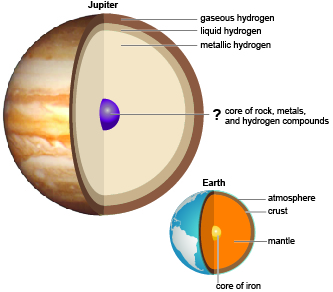1 Terrestrial and giant planets
The eight planets in our Solar System can be split into two main categories.
The four inner planets, of which Earth is the largest, are all rocky planets. Because they are like the Earth, we call them the terrestrial planets. Mars is the outermost terrestrial planet, about one and a half times as far from the Sun as the Earth is. Beyond Mars is the asteroid belt.
On the other side of the asteroid belt, things are very different. The next planet, Jupiter, is about five times the Earth’s distance from the Sun. The four large outer planets, Jupiter, Saturn, Uranus and Neptune, aren’t made of rock – instead, they are large balls of gas held together by gravity. Collectively, they are referred to as the giant planets. Jupiter and Saturn are called the gas giants. Because Uranus and Neptune are even further from the Sun than Jupiter and Saturn are and are extremely cold, they are referred to as the ice giants.
Terrestrial planets and giant planets have very different structures (Figure 1). Planets like Earth are mostly made of rock, possibly with an iron core. Planets like Jupiter are made almost entirely of hydrogen. Astronomers are not absolutely sure what goes on in the interior of the gas planets, but they think that at very high pressures the hydrogen gas may start to behave like a metal. A big question is whether Jupiter has a small rocky core or not. New results from NASA’s Juno spacecraft orbiting Jupiter since 2016 may soon answer this.

